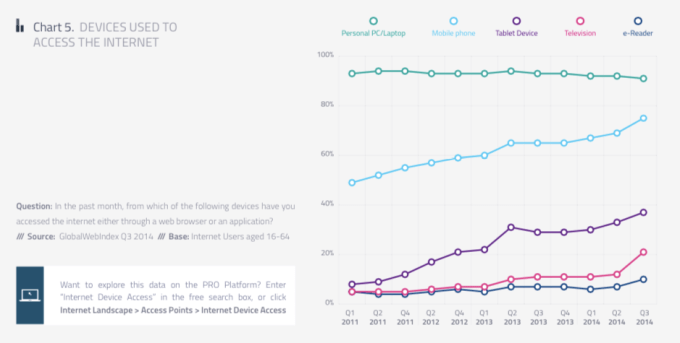Here Digital Marketing Blog gives you the top 5 mobile marketing tips for the travel and hospitality industry.
Mobile marketing is today’s emerging trend, and mastering it can make the difference between increased conversion and stagnation. Let’s explore how Travel and Hospitality industry leaders structure their mobile apps and then see what we can learn from some of the most successful brands in the world.
Mobile Marketing Overtake – Are We There Yet?
Two years ago, Gartner, Inc. predicted mobile devices would overtake PCs worldwide by 2015, saying: “In 2015, Smartphone and tablet sales will outsell PCs worldwide. They will become preferred devices to surf the Internet. This is already the case within many emerging markets. The consequence of this phenomenon is that each and every organization needs to re-think its digital strategy.”
It is now 2015, and mobile has indeed overtaken PCs. Mobile phone penetration rates in the West are over 100 percent. 74 percent of people have a smartphone and can receive emails pointing to mobile websites. Since 70 percent of smartphone users are willing to receive push messages, you can push a direct link to mobile apps to 52 percent of the population.
So, have all e-tailers positioned themselves properly on these two aspects of mobile marketing: mobile apps and mobile Web (yes, I’m skipping mobile social, even though it’s big, because it deserves a blog post of its own)?
Hardly. A recent InternetRetailing article on retailer mobile-friendliness quotes SciVisum’s Christmas 2014 eCommerce Mobile Experience Report, reporting that in the run-up to the critical holiday shopping season, 7 of the 10 leading UK e-tailers weren’t mobile-friendly, with two serving desktop-optimized pages to mobile devices. 7 of the 10 took more than 2 seconds to load a page on mobile devices, even with cell signal speed taken out of the equation.
Stats from Greenlight show ‘cheap flights’ was the most popular Google UK flight search term at 17 percent overall and 20 percent of mobile-based searches, yet only half of the top 10 sites returned by that search were responsive.
Tip #1: Increase Mobile Conversion through Responsive Web Design

According to an eConsultancy report on responsive design in the travel industry, only 1 of the 50 top airlines in the world implemented CSS restyling based on user agent detection. 76 percent had a dedicated mobile site, and 22 percent served PC-optimized pages to mobile devices. According to the report, of the 11 top UK carriers, only 1 had a responsive design, Thomas Cook Airlines, who reported a 30 percent increase in mobile conversion after switching. When Travelocity moved to responsive web design, it saw a 6 to 8 percent increase in mobile bookings.
Tip #2: Mobile Web: Simplicity Pays Off
According to a ForeSee report on mobile user satisfaction, Southwest Airlines leads the travel industry pack at 82 points out of 100 possible. Its nearest airline competitor lagged at 77, and even the highest-rated hotel chains, Choice and Marriott, came in behind at 80 and 79, respectively. The airline’s simple no-frills and no-surprise approach translated into a simple mobile experience that users appreciate.
Expedia’s new app for tablets offers a streamlined user experience, allowing combined flight and hotel searches. They’ve also incorporated Scratchpad so customers can save an itinerary they’ve started putting together, allowing them to return to it later using their tablet or any other Web-capable device.
Another travel brand banking on simplicity, AirBnB simplified its mobile user experience by turning to larger, cleaner images, hoping to entice users to move from browsing to booking.
Tip #3: Make the Customer’s Life Easier
Customers can get irritated by having to laboriously enter information into a mobile app. Sam’s Club’s app is designed to help by snapping a picture of the customer’s credit card and auto-populating the information. Next time, the information is already there.
An eConsultancy report on the perfect mobile travel experience notes that customers need help to feel comfortable pulling the trigger on travel purchases because such purchases tend to have high costs. Sam’s Club customer support helps around-the-clock with any problems or questions, offering the retailer a significant edge.
Travelocity rebuilt its iPhone app to take advantage of iOS 7’s gesture-based features and the ability to capture credit card information using the iPhone camera, similar to the Sam’s Club app, as well as simplifying the user experience in other ways.
Priceline’s app takes advantage of tablet and phone touch-screen feature, letting users define a search area by drawing a circle on an interactive map with their finger.
JetBlue is integrating boarding passes into Apple’s Passbook, and will soon use mobile boarding passes on Android too. They’re certainly not the only ones. Passbook is a hot trend for airlines!
Making your customer’s life easier isn’t limited to the things your own business offers. Hyatt’s app, for example, provides easy access to Uber and car rentals, including estimated price for a trip, confirmation codes, phone numbers, reservation dates and times, etc.

Tip #4: Provide Valuable Exclusive Offers
Getting consumers to download an app to their phone is hard enough. Getting them to keep using it for the long haul is much harder. If you want users to stick with your app, give them app-exclusive offers, options, or services to make it worth their while. Travelocity, Groupon, and Expedia all said in recent articles that they offer such exclusive offers to their app users.
Tip #5: Geo-targeting – Give to Get
In my recent post, 2 Less-Obvious Ways to Leverage Beacons, the Next Marketing Tsunami, I explored the explosive growth of beacons. Mobile Marketer talked with several marketers, including Rob Murphy, vice president of marketing at Swirl, Boston. This conversation makes it clear that, although consumers hesitate to share information, if brands offer enough value, consumers will give their info to get the offer. As Murphy says, “Seventy-seven percent of consumers said that they would be willing to share their smartphone location information, as long as they receive enough value in return.” Clearly, if you want to overcome consumer hesitation, you have to figure out what offer will seal the deal.
Expedia’s app also uses time and location information to zoom in on the part of the trip that the customer is likely most interested in, the next leg. This includes airport maps, airline locator code, flight status, etc., offered right when needed.
Takeaway
As these Travel and Hospitality industry leaders demonstrate, your website has to be responsive so that a mobile user’s experience isn’t a watered-down version of your PC-optimized site but a full version that’s visually optimized for smaller screens and input-optimized for finger and gesture control.
Your app can’t be a “me-too” version of your website either. If you want your customers to download it and keep using it, it has to offer sufficient value. This can be offers or services available only through the app, an especially simple and smooth user experience, timely personalized offers and services informed by the customer’s name and location, and/or a convenient-to-use interface that takes into account the limitations of smaller screens. Above all, your app has to take advantage of mobile-specific capabilities, such as GPS location, Passbook, credit card imaging, finger and gesture control, geolocation mashup with TripAdvisor and Uber, etc.
Are you already implementing any of these 5 tips? If you are, what results have you seen?
Original article found here












